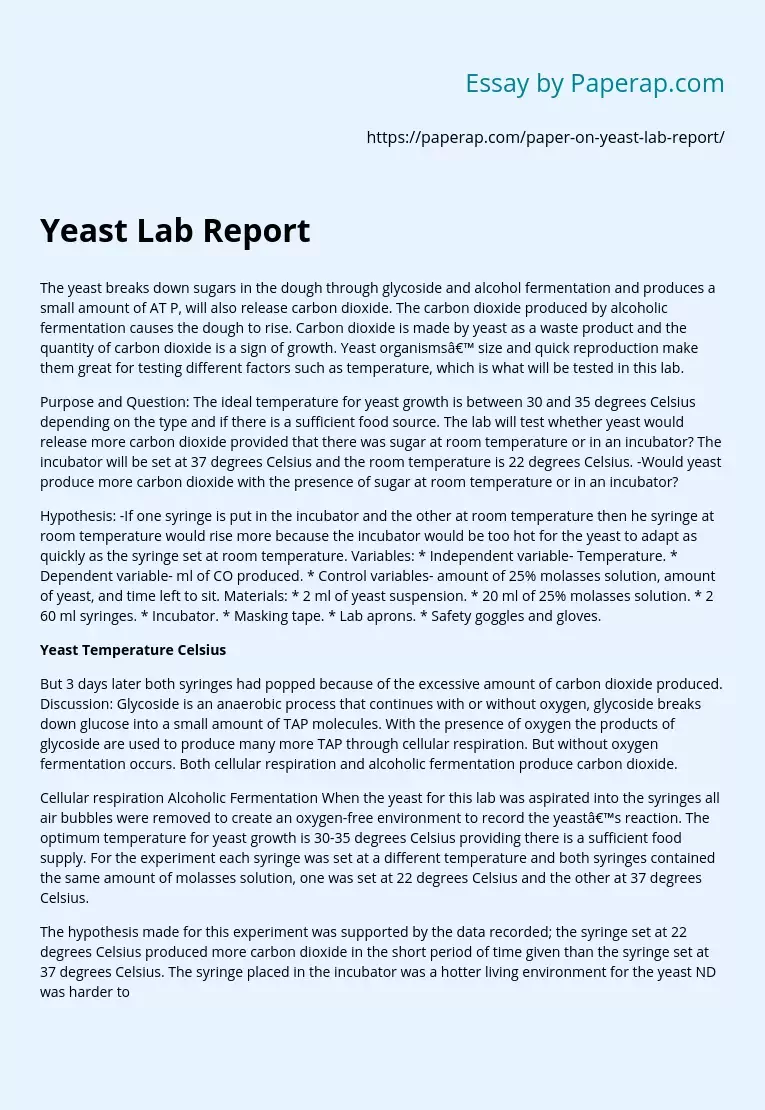Yeast Lab Report
The yeast breaks down sugars in the dough through glycoside and alcohol fermentation and produces a small amount of AT P, will also release carbon dioxide. The carbon dioxide produced by alcoholic fermentation causes the dough to rise. Carbon dioxide is made by yeast as a waste product and the quantity of carbon dioxide is a sign of growth. Yeast organisms’ size and quick reproduction make them great for testing different factors such as temperature, which is what will be tested in this lab.
Purpose and Question: The ideal temperature for yeast growth is between 30 and 35 degrees Celsius depending on the type and if there is a sufficient food source. The lab will test whether yeast would release more carbon dioxide provided that there was sugar at room temperature or in an incubator? The incubator will be set at 37 degrees Celsius and the room temperature is 22 degrees Celsius. -Would yeast produce more carbon dioxide with the presence of sugar at room temperature or in an incubator?
Hypothesis: -If one syringe is put in the incubator and the other at room temperature then he syringe at room temperature would rise more because the incubator would be too hot for the yeast to adapt as quickly as the syringe set at room temperature.
Variables: * Independent variable- Temperature. * Dependent variable- ml of CO produced. * Control variables- amount of 25% molasses solution, amount of yeast, and time left to sit. Materials: * 2 ml of yeast suspension. * 20 ml of 25% molasses solution. * 2 60 ml syringes. * Incubator. * Masking tape. * Lab aprons.
* Safety goggles and gloves.
Yeast Temperature Celsius
But 3 days later both syringes had popped because of the excessive amount of carbon dioxide produced. Discussion: Glycoside is an anaerobic process that continues with or without oxygen, glycoside breaks down glucose into a small amount of TAP molecules. With the presence of oxygen the products of glycoside are used to produce many more TAP through cellular respiration. But without oxygen fermentation occurs. Both cellular respiration and alcoholic fermentation produce carbon dioxide.
Cellular respiration Alcoholic Fermentation When the yeast for this lab was aspirated into the syringes all air bubbles were removed to create an oxygen-free environment to record the yeast’s reaction. The optimum temperature for yeast growth is 30-35 degrees Celsius providing there is a sufficient food supply. For the experiment each syringe was set at a different temperature and both syringes contained the same amount of molasses solution, one was set at 22 degrees Celsius and the other at 37 degrees Celsius.
The hypothesis made for this experiment was supported by the data recorded; the syringe set at 22 degrees Celsius produced more carbon dioxide in the short period of time given than the syringe set at 37 degrees Celsius. The syringe placed in the incubator was a hotter living environment for the yeast ND was harder to adapt to than the syringe set at room temperature. At high temperatures yeast begins to die which explains why in when bread is baked the yeast inside the dough dies and the alcohol produced also evaporates.
Yeast Lab Report. (2019, Dec 05). Retrieved from https://paperap.com/paper-on-yeast-lab-report/

